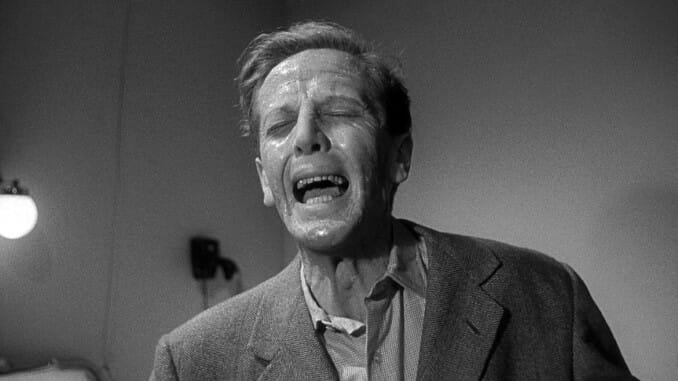Introducing Endless Mode: A New Games & Anime Site from Paste
Paste’s ABCs of Horror 2 is a 26-day project that highlights some of our favorite horror films from each letter of the alphabet. The only criteria: The films chosen can’t have been used in our previous Century of Terror, a 100-day project to choose the best horror film of every year from 1920-2019, nor previous ABCs of Horror entries. With many heavy hitters out of the way, which movies will we choose?
As the 1950s dawned, the U.S. film industry was mired in what was perhaps its longest drought of proper horror cinema, a true low point for the genre. Studios surmised at the time that post-war audiences had no interest in the hoary old monster movies and mad doctor stories that Universal had proliferated so readily throughout most of the 1940s, and were instead craving more “modern” tales that could reflect, on some level, the changed world that now existed in the nuclear age. Ultimately, it was the nascent science fiction genre that would give horror a route back into cinemas, via films like The Thing From Another World or The Man From Planet X in 1951, but the front half of the decade is still pretty fallow horror ground regardless, notable only for the rise of the “giant monster” movie via the likes of Godzilla and Them!. It wouldn’t be until the back half of the decade that more classical horror would return to prominence … and it wouldn’t be the U.S. leading the charge.
Across the pond, it was Britain’s Hammer Film Productions that would ultimately spearhead what turned into a global horror revival, as they embraced the spirit of the age in returning the old monsters to colorful life, rendering the likes of Frankenstein’s Monster or Dracula frightening once again in a new era of plunging necklines and lurid splashes of Eastmancolor blood. But before The Curse of Frankenstein or Horror of Dracula, there was The Quatermass Xperiment. This was the true genesis of what would quickly coalesce into “Hammer Horror,” an atmospheric melding of body horror and science fiction that embraced those newly “modern” post-war sensibilities while also laying a foundation for numerous sci-fi horrors to come. No less than John Carpenter would go on to say that the film “had an enormous, enormous impact on me”—impact that can clearly be seen in his remake of The Thing almost 30 years later. Today, The Quatermass Xperiment has more or less slipped from the cultural consciousness, but you can see its progeny everwhere.
The Quatermass Xperiment is, at heart, an oddball merging of science fiction parable, film noir, police procedural and “monster on the loose” chiller, which begins when the first manned rocket crew shot into space experiences a mysterious phenomenon and crashes back to Earth. With two crew members missing, and the only living soul aboard rendered catatonic, the film is initially presented as a mystery … right up until the only surviving crew member Carroon (Richard Wordsworth, in an empathetic and haunted performance that evokes Karloff’s monster) begins to slowly transform into something not of this world. Wordsworth truly conveys the silent horror of this process, his face becoming a gaunt, hollow portal of despair, as if he dimly understands that his consciousness will be stripped away, bit by bit and replaced with alien cunning.
The titular “Quatermass,” meanwhile, is the name of an American professor (Brian Donlevy) who speaks more like a film noir street tough than an academic as he oversees the program and the subsequent attempt to medically save Carroon. The efforts are for nought, of course—the monster eventually ends out rampaging on the streets as we all knew he would, but the focus on Quatermass is intriguing in the way it paints him not as the “man of progress” he claims to be, but as an uncaring, methodical and ultimately despicable researcher who cares more about the discoveries to be made (and presumably the accompanying fame) than the welfare of his own crew. He has an almost tyrannical air, brutally efficient and often logically sound, but devoid of human feeling, culminating in what is perhaps the film’s most chilling moment as Quatermass declares his intention to send more men into space immediately after destroying the monster his last crew member became. It’s impossible to look at Quatermass and not see a rebuke of the casual misanthropy of both the corporate and scientific worlds—he’s the villain of the film just as much as the extraterrestrial being turning people and animals into desiccated husks.
The ideas of The Quatermass Xperiment would go on to be co-opted heavily in American science fiction horror movies of the late 1950s, such as The Creeping Terror (Quatermass was itself titled The Creeping Unknown in the U.S.) and especially Night of the Blood Beast, which is essentially a much lower quality version of the same story. By the end, it also seems like a clear inspiration for The Incredible Melting Man and The Blob, as the thing that was once Carroon has become a quivering mass of tendrils and slime. Notably, it bears little resemblance to the classically creepy, color-enhanced gothic horrors that Hammer would bring to the international stage only a few years later, but without the success of Quatermass (which had several sequels), one wonders if we ever would have seen Christopher Lee as Dracula or Peter Cushing as Dr. Frankenstein. The horror landscape could have been fundamentally altered, if not for this noir-tinged tale of a mutant astronaut on the loose. That’s the legacy of Quatermass, the launching pad for the golden era of British horror.
Jim Vorel is a Paste staff writer and resident horror guru. You can follow him on Twitter for more film and TV writing.
